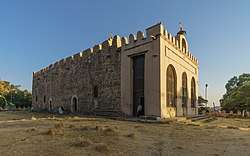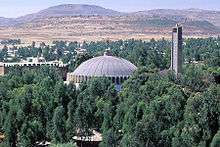Church of Our Lady Mary of Zion
The Church of Our Lady Mary of Zion (Amharic: ርዕሰ አድባራት ቅድስተ ቅዱሳን ድንግል ማሪያም ፅዮን Re-ese Adbarat Kidiste Kidusan Dingel Maryam Ts’iyon) is an Ethiopian Orthodox Tewahedo Church in Ethiopia. It is claimed to contain the Ark of the Covenant. It is located in the town of Axum, Tigray. The original church is believed to have been built during the reign of Ezana the first Christian ruler of the Kingdom of Axum (Present-day Eritrea and Ethiopia), during the 4th century AD, and has been rebuilt several times since then.[1]

History


Since its founding during the episcopacy of Frumentius (known in Ethiopia as Abune Selama Kesatie Birhan or "Our Father of Peace the Revealer of Light") the Church of Mary of Zion has been destroyed and rebuilt at least twice. Its first putative destruction occurred at the hands of Queen Gudit during the 10th century. Its second, confirmed, destruction occurred in the 16th century at the hands of Ahmad ibn Ibrihim al-Ghazi, after which it was rebuilt by the Emperor Gelawdewos, then further rebuilt and enlarged by Fasilides during the 17th century.[2][3] St. Mary of Zion was the traditional place where Ethiopian Emperors came to be crowned. And indeed, if an Emperor was not crowned at Axum, or did not at least have his coronation ratified by a special service at St. Mary of Zion, he could not be referred to by the title of "Atse".[4][5][6]

In the 1950s, the Emperor Haile Selassie built a new modern Cathedral that was open to both men and women next to the old Cathedral of Our Lady Mary of Zion. The old church remains accessible only to men, as Mary, symbolized by the Ark of the Covenant allegedly resting in its chapel, is the only woman allowed within its compound.
The church is a significant center of pilgrimage for the Ethiopian Orthodox Tewahedo Church, especially during the main Festival of Tsion Mariam on 30 November (21 Hidar on the Ethiopian calendar).
Ark of the Covenant
St. Mary of Zion claims to contain the original Ark of the Covenant. Reportedly, the Ark was moved to the Chapel of the Tablet adjacent to the old church because a divine 'heat' from the Tablets had cracked the stones of its previous sanctum. Emperor Haile Selassie's wife, Empress Menen, paid for the construction of the new chapel.
According to tradition, the Ark came to Ethiopia with Menelik I after he visited his father King Solomon. Only the guardian monk may view the Ark,[7] in accordance with the Biblical accounts of the dangers of doing so for non-Kohanim. This lack of accessibility, and questions about the account as a whole, has led Ethiopians and foreign scholars alike to express doubt about the veracity of the claim.[8] The guardian monk is appointed for life by his predecessor before the predecessor dies. If the incumbent guardian dies without naming a successor, then the monks of the monastery hold an election to select the new guardian. The guardian then is confined to the chapel of the Ark of the Covenant for the rest of his life, praying before it and offering incense.[9]
In a 1992 interview, Edward Ullendorff, former Professor of Ethiopian Studies at the University of London, says that he personally examined the ark contained within the church in 1941 while a British army officer. Describing the ark, he says, "They have a wooden box, but it's empty. Middle- to late-medieval construction, when these were fabricated ad hoc."[10][11]
Burials
- Tekle Giyorgis I, in the churchyard
References
| Wikimedia Commons has media related to Church of Our Lady Mary of Zion, Axum. |
- "Sacred Sites of Ethiopia and the Arc of the Covenant". Sacredsites.com. Archived from the original on 2016-08-19. Retrieved 2016-08-26.
- UNESCO World Heritage Centre. "Aksum - UNESCO World Heritage Centre". Whc.unesco.org. Archived from the original on 2016-06-21. Retrieved 2016-08-26.
- "Microsoft Word - EOTC - English version.doc" (PDF). Archived (PDF) from the original on 2017-04-29. Retrieved 2016-08-26.
- Paul Raffaele. "Keepers of the Lost Ark? | People & Places | Smithsonian". Smithsonianmag.com. Archived from the original on 2016-08-18. Retrieved 2016-08-26.
- "Ethiopia & Eritrea - Jean-Bernard Carillet, Stuart Butler, Dean Starnes - Google Livres". Books.google.ch. Archived from the original on 2016-08-08. Retrieved 2016-08-26.
- "en_070" (PDF). Archived (PDF) from the original on 2016-04-15. Retrieved 2016-08-26.
- "Smithsonian magazine investigates the Ark". Archived from the original on 2014-10-19. Retrieved 2014-10-15.
- Ethiopian skepticism of the claims to the Ark have been documented since at least the 15th century. See:
- Pennec, Hervé; Boavida, Isabel; Ramos, Manuel João, eds. (2013). Pedro Páez's History of Ethiopia, 1622. Ashgate Publishing. p. 122. ISBN 9781409482819.
- Haile, Getachew, ed. (2003). The Geʻez Acts of Abba Esṭifanos of Gwendagwende. Leuven: Peeters. p. 47. ISBN 978-90-429-1740-8.
- "L'Arche d'Alliance en Ethiopie ?". Histoire-pour-tous.fr. Archived from the original on 2016-10-30. Retrieved 2016-08-26.
- Hiltzik, Michael. "Documentary : Does Trail to Ark of Covenant End Behind Aksum Curtain? : A British author believes the long-lost religious object may actually be inside a stone chapel in Ethiopia". Los Angeles Times. Archived from the original on 24 October 2019. Retrieved 24 October 2019.
- Jarus, Owen. "Sorry Indiana Jones, the Ark of the Covenant Is Not Inside This Ethiopian Church". Live Science. Archived from the original on 1 October 2019. Retrieved 24 October 2019.
- Stuart Munro-Hay (2005), The Quest for the Ark of the Covenant, Ch. 6